One of the most characteristic genres of the Hellenistic period was didactic poetry: the art of turning a technical or scientific subject into a literary work. This practice reflected the era’s deep integration of scholarship and art, as poets at centers like Alexandria sought to make complex knowledge from fields like astronomy or pharmacology accessible and elegant through verse. Reading these works requires an appreciation for this unique fusion of science and literature.
The goal of didactic poetry was not just to teach (docere) but also to delight (delectare). The challenge for the poet was to present factual information accurately while also creating a polished, engaging, and artistically satisfying poem. The most successful example of this genre from the period is the astronomical poem, the ‘Phaenomena’.
⭐ Aratus and the Phaenomena
The most famous didactic poem of the Hellenistic age is the Phaenomena by Aratus of Soli (c. 315–c. 240 BC). This poem is a versification of a prose treatise on astronomy by the 4th-century mathematician Eudoxus. In just over 1,100 hexameter lines, Aratus describes the constellations, the celestial circles, and the movements of the stars, and also includes a section on weather signs.
The ‘Phaenomena’ was immensely popular in the ancient world for several reasons:
- Elegance and Clarity: Aratus succeeded in turning dry technical data into smooth, elegant verse. His descriptions of the constellations are clear and memorable.
- Stoic Philosophy: The poem is infused with a sense of Stoic wonder at the order and rationality of the cosmos. Aratus begins with a hymn to Zeus, portraying the divine order that governs the heavens as a benevolent guide for humanity.
- Practicality and Artistry: It was both a practical guide for farmers and sailors who needed to read the stars and a sophisticated work of literature for an educated urban audience.
📜 The Didactic Tradition
Aratus’s success inspired many other poets to tackle scientific and technical subjects. Another notable example is Nicander of Colophon, who wrote poems on toxicology (Theriaca) and antidotes (Alexipharmaka). While perhaps less poetically gifted than Aratus, Nicander’s work demonstrates the broad appeal of the didactic genre.
These poets were not scientists themselves, but literary artists who saw the potential for poetry in the expanding world of Hellenistic knowledge. They took scholarly prose and transformed it, using the tools of meter, metaphor, and literary allusion to create a new kind of literature that was both informative and beautiful, perfectly embodying the intellectual spirit of their age.
More Topics
- How Philosophy Influenced Hellenistic Writing
- How to Understand the Hellenistic Book Roll
- How Literary Rivalry Shaped Hellenistic Poetry
- How to Appreciate Hellenistic Women Poets
- How Scholarship Became Literature in the Hellenistic Era
- How Royal Patronage Shaped Hellenistic Literature
- How to Experience Hellenistic Mime and Popular Entertainment

